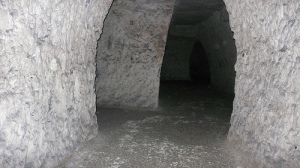
Recently I appeared on Radio 4’s Questions Questions answering a query about composer Alvin Lucier’s work “I am sitting in a room”. This is a strange and fascinating demonstration of how a room resonates – or for this recording how a cave resonates. On the train down to the recording, I simulated the sound on my laptop. I did this out of idle curiosity to pass the time on the long journey, but it turned out to be very useful because I had to be interviewed before they had done the experiment for real: it was a good job I knew what it might sound like!
This is my simulation of the I am sitting in a room mp3 (not using the original text)
In the work, a piece of text is read into the cave and recorded on a microphone. The sound picked up on the microphone is then replayed out of a loudspeaker in the cave and again picked up by the microphone, which is then fed back to the loudspeaker and played into the cave, and so on. So the speech goes through the cave, from the loudspeaker to the microphone, over and over again. As the sound passes through the cave more and more times it becomes increasingly distorted. First the words start to become indistinct, then they become completely unintelligible, although you can still here the rough rhythm of the words. Eventually, all that is left is strange ringing sounds.
What is being heard is how a room alters and distorts the speech. We hear this everyday, and is most obvious in places like a bathroom (where even poor singers can claim to be like Pavarotti) or in grand cathedrals where the sound can be heard echoing and reverberating around the large cavernous space. Normally, a piece of speech only passes through the bathroom or cathedral once. However, in the “I am sitting in a room” piece, the speech is repeatedly passed through the cave over and over again, so what is heard is speech altered beyond what would happen naturally.
In a room there are certain sound frequencies (or pitches) that are emphasised by the resonances of the room. This is why if you singing a tune in the shower some notes sound very booming and impressive whereas others at different frequencies aren’t quite so good. Every time the speech was passed through the cave, sound at the cave’s resonant frequencies got emphasised while other frequencies were not. And if a few frequencies are repeatedly emphasised over and over again, eventually all this is left is sound at those frequencies: these are the strange ringing sounds at the end of the recording.
Photo http://www.flickr.com/photos/richardsummers/3870974952/ Some rights reserved ![]()
0 responses to “I Am Sitting in Chislehurst Caves”
Thanks for your impressions in that cave. I guess it was a really interesting experiment. Maybe I can repeat it in my bathroom ;-). Which were the frequencies that were pushed most?
Should work in a bathroom provided you don’t electrocute yourself. Frequencies will be something in speech which hits a room resonance, so I guess somewhere between 200 and 2000 Hz.
Trevor